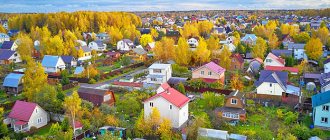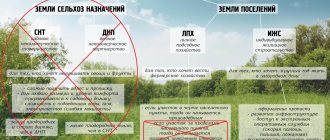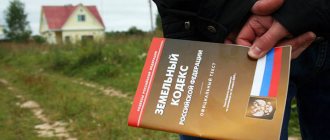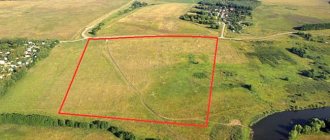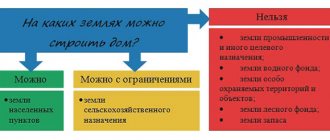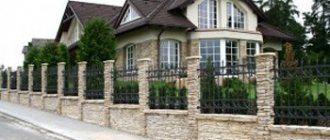Is it possible to buy a plot for a summer cottage and a house if it is located on agricultural land? If you need a short, unambiguous answer, you can simply say: YES, you can. And add: NO, you can’t. Because without an accurate understanding of EXACTLY WHAT agricultural land it is, it is impossible to give an answer about its suitability for building even a light and non-permanent house.
Most buyers of land for the construction of a country house are afraid of such characteristics of the site as its agricultural purpose. Although there is nothing terrible about it. Moreover, they cost much less than land with the status of “individual housing construction”.
It is possible to build on plots of agricultural land. But not at all and not all. And you need to figure this out in order not to let yourself be misled by would-be sellers, and it’s not that difficult if you use our instructions. And in this case, you should not limit yourself to the information indicated about the site in the cadastral documents. Sometimes data is entered into the cadastre with delays, so it is better to check everything further before purchasing land.
conclusions
So, the main conclusion is that a house can be legally built on agricultural land if three conditions are met:
- if the % of development of the site does not exceed that established specifically for this type in the PZZ;
- the size of the plot is between the min and max specified in the PZZ;
- it is assumed that it can be owned by an individual.
As you can see, checking the land is not the easiest story. And in general, it is logical that most buyers of plots are afraid to purchase agricultural plots for construction, especially for houses for permanent residence, for which it is advisable to choose land either in an already established and repeatedly tested village, or with the status of individual housing construction.
Did you find this article helpful? Please share it on social networks: Don't forget to bookmark the Nedvio website. We talk about construction, renovation, and country real estate in an interesting, useful and understandable way.
Arable land straight ahead
The highest rates of growth in land value are observed in the central regions (Voronezh, Kursk, Lipetsk, Oryol, Tula and other black earth regions). The south is lagging behind: prices here were initially higher than in the center, and in recent years the situation has been aggravated by drought. Today, in the southern regions, land costs almost the same as in the center of the country. Thus, prices in the Krasnodar region range from 180 to 270 thousand rubles per hectare, in the Rostov region - from 70 to 150 thousand rubles per hectare. In the Stavropol Territory, the cost of land is at the level of 80-150 thousand rubles per hectare. For the same money (or even more) you can buy a plot of land in the Kursk region - 100-150 thousand rubles per hectare. In the Lipetsk and Oryol regions, prices were around 100 thousand rubles per hectare, in the Tula region - 50-90 thousand rubles per hectare, data is provided in BEFL.
The main reason for the rise in land prices in the center is the increase in the profitability of crop production against the backdrop of good yields, rising costs of crop production and a depreciation of the ruble. Investors (including non-core ones) regarded these factors as a signal for purchases in the central regions. High demand has led to rising prices, explains BEFL Managing Director Vladislav Novoselov. At the same time, there are not many large good plots of land available for free sale. According to the expert, several hectares of land for a family farm can now be purchased in almost any agricultural region - the question is the price. But it is much more difficult to find 5-10 thousand hectares or more. Now interesting objects are easier to find in the Volga region, in the south of the Urals and Siberia. “The more east the region is, the cheaper crop products are, and processed and livestock products are more expensive than in the western part of Russia (due to transportation costs),” explains Novoselov.
The price rises following the profitability of the agricultural business. Export growth provides additional benefits, rising prices on the foreign market are additional incentives, as is the weakening of the ruble, agrees Natalya Shagaida, director of the Center for Agricultural Policy at RANEPA. In the east of the country until recently there was a lot of unregistered land. Therefore, it is easier to buy from the primary owners. And in the south and center the lands have long been owned by those who really need them. It's more expensive to buy from them.
The rise in prices for agricultural land is primarily due to an improvement in the quality of assets. “Land in regions with established infrastructure generate more income. Registered plots of large area with a transparent history of ownership are valued higher than those where, for example, there are share owners,” explains Daria Snitko, head of the economic forecasting center at Gazprombank.
In 2021, Russia received its second-ever grain harvest (133.5 million tons). At the same time, the pandemic led to an increase in prices for basic food, and farmers were able to earn good money. According to the UN Food and Agriculture Organization (FAO), prices for grain, vegetable oils and other food items reached multi-year highs. But Russia is still far from exhausting its growth potential. The country has more than 100 million hectares of arable land (about 10% of the world). Over the next ten years, the Ministry of Agriculture plans to introduce another 13 million hectares into agricultural production. At the same time, the share of Russian agricultural products on the world market is only 2%. Canada, located at the same latitude, harvests 40 centners per hectare of grain, and Russia – 26 centners per hectare, note the Center for Agricultural Analytics at the Ministry of Agriculture.
Agricultural land has risen in price due to high demand, but there are not many large good plots of land available for free sale
But this does not mean that agricultural land in Russia is a profitable investment option, experts say. The land needs to be cultivated and, therefore, invested in equipment and personnel. They cannot simply be held as another asset, says Daria Snitko. According to Shagaida, buying, for example, two hectares is a bad investment. To get a tangible profit, you need hundreds of hectares on which you will have to organize agricultural production and organize sales of products. In addition, this year farmers are unlikely to receive such a large profit - the rising cost of resources, as well as government measures to curb prices for basic types of crop products, will have an impact, Novoselov believes. Therefore, we should expect a slowdown, and possibly a stop, in the growth of the value of agricultural land, the expert believes.
Peculiarities
Settlement land is a territory that is intended for development and growth of villages and cities. These territorial areas consist of zones:
- public and business;
- residential;
- industrial;
- recreational;
- infrastructure (transport and engineering);
- agricultural use and others.
More details about the composition and use of land in settlements can be found here.
All this is regulated by Article 83 of the Land Code of the Russian Federation.
We examined the legal regime of land in populated areas in more detail in this material.
The Land and Town Planning Code determines that the complex of zones for agricultural use includes:
- hayfields;
- arable land;
- areas with perennial plantings;
- pastures;
- structures and buildings used for dacha, rural, private plot and horticultural farming.
A distinctive feature of these agricultural plots is the fact that they are used for agricultural purposes until the type of their use is changed in accordance with the general design of settlements and instructions for land use and development, approved by local administrative bodies, based on the needs of the settlement.
Changing the type of use is possible only if the priority for the growth and development of a settlement is normatively established, therefore these lands can be built up with residential buildings or buildings for other purposes.
It is worth understanding that the local administration has the right (within its competence) to dispose and manage all plots of agricultural land that are located within the boundaries of a given settlement. The same right applies to undifferentiated land tenures.
Agricultural territories that will be located within the boundaries of settlements are characterized by a mixed order of legal regulation, thus, despite the fact that they are included in the texture of the lands of settlements, these areas are in no way deprived of national economic properties - use for the needs of the agricultural economy.
How to transfer to another category
All types of plots are divided into zones according to types of permitted use. A VRI is a detailed list of activities that can be carried out in a specific area. All soils are registered in the classifier and each unit is assigned an individual code in the form of a set of numbers.
How to change classification Source ok.ru
If the owner wants to build a house on the plot, then a change in the category of agricultural land is necessary. To solve the problem, the territory is often transferred to the boundaries of a populated area. A person will have to compensate the difference between the cost of an agricultural plot and individual housing construction. Sometimes pushing the boundaries is enough.
How the category is changed Source fbc.ua
To change the category of land, you need to contact the local governing body with an application. The text indicates the cadastral number, authority for the site and justification for the change. The application may take up to 2-3 months to be considered. If the result is positive, they give permission for the transfer, which will arrive by mail within 2 weeks. The refusal can be challenged in court.
Why measure in hectares?
The hectare has been used as a unit of measurement in Russia since the 60s. twentieth century, when the international system of weights and measures (SI) was formed. However, it is not included in this system. Currently, the hectare as a unit of measurement is used in legal and metric systems to indicate the area of certain territories.
A hectare is a unit of area equal to the area of a square with a side of one hundred meters.
In Russia, this unit is used to measure the area of agricultural plots, as well as forest plots registered. When denoting an area in hectares, its abbreviated designation is accepted - ha (in the international system - ha ).
Measuring area in hectares is quite convenient, since it makes it quite easy to determine the number of hectares in a particular area if you know its length and width in meters (one hectare is equal to ten thousand square meters).
What not to do
Agricultural land is a special category, the use of which is controlled by the state. The territories are considered a strategic resource and natural heritage, and are therefore carefully protected. The plots can only be used for agricultural purposes; in case of violation, the culprit will be prosecuted by law.
Arable lands have a high cadastral value, so they cannot be transferred to other sections. Any activity that is not related to agriculture is not allowed on the territory. In areas under state protection, the construction of any structures is prohibited.
What is prohibited when using Source wave.vinnica.ua
On other types of land it is impossible to engage in commercial activities and build housing. If the owner sets up a store or equips a small hotel (hostel), then the actions are considered a violation of the law. Houses are allowed to be built within the boundaries of a village or city.
In case of inappropriate use of agricultural land, the culprit will be fined. The amount of punishment for individuals is from 0.5 to 1% of the cadastral value, but not less than 10 thousand rubles. Officials face sanctions in the range of 1-1.5% and 20 thousand. For enterprises, the penalty is 1.5-2% or at least 100 thousand.
Fine for inappropriate use Source narodna-pravda.ua

